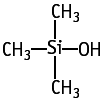

Trimethylsilanol was studied for oral toxicity in rats in a 28-day repeat dose toxicity test at doses of 0, 10, 40, 160 and 640 mg/kg. Decreased spontaneous motor activity and staggering gait were observed in both sexes given 640 mg/kg. Moreover, gait difficulty was observed in males given 640 mg/kg. Body weight gain tended to be suppressed and fibrinogen increased in both sexes given 640 mg/kg, along with absolute thymus decrease and relative liver weight increase in females. The changes in body weights in males and in relative liver weights in females were still found at the end of a 14-day recovery period . The NOEL for repeat dose toxicity is considered to be 160 mg/kg/day for both sexes.
Trimethylsilanol was not mutagenic in Salmonella typhimurium TA100, TA1535, TA98 and TA1537 or Escherichia coli WP2 uvrA.
Trimethylsilanol did not induce structural chromosomal aberrations or polyploidy in CHL/IU cells with or without an exogenous metabolic activation system.
| Purity | : | 99.8 % |
| Test species/strain | : | Rats/Crj:CD(SD) |
| Test method | : | Guidelines for 28-day Repeat Dose Toxicity Testing of Chemicals(Japan) |
| Route | : | Oral |
| Doses | : | 0(vehicle), 10, 40, 160, 640 mg/kg/day |
| Number of animals/group | : | Males, 5; females, 5 |
| Vehicle | : | Corn oil |
| Administration period | : | Males and females, 28 days |
| Terminal kill | : | Males and females, days 29 or 43 |
| GLP | : | Yes |
Test results:
| Purity | : | 99.8 % |
| Test species/strain | : | Salmonella typhimurium TA100, TA1535, TA98, TA1537, Escherichia coli WP2 uvrA |
| Test method | : | Guidelines for Screening Mutagenicity Testing of Chemicals (Japan) and OECD Guidelines No. 471 and 472 |
| Procedures | : | Pre-incubation method |
| Solvent | : | DMSO |
| Positive controls | : | -S9 mix; AF-2(TA100, TA98), Sodium azide(TA1535), ENNG(WP2 uvrA) and 9-Aminoacridine(TA1537) +S9 mix; 2-Aminoanthracene(all strains) |
| Doses | : | -S9 mix; 156, 313, 625, 1250, 2500, 5000 μg/plate(TA100, TA1535); 313, 625, 1250, 2500, 5000 μg/plate(WP2 uvrA, TA98, TA1537) +S9 mix; 156, 313, 625, 1250, 2500, 5000 μg/plate(TA100); 313, 625, 1250, 2500, 5000 μg/plate(TA1535, WP2 uvrA, TA98, TA1537) |
| S9 | : | Rat liver, induced with phenobarbital and 5,6-benzoflavone |
| Plates/test | : | 3 |
| Number of replicates | : | 2 |
| GLP | : | Yes |
Test results:
Genotoxic effects:
S. typhimurium TA100, TA1535, TA98, TA1537
| + | ? | - | |
| Without metabolic activation: | [ ] | [ ] | [*] |
| With metabolic activation: | [ ] | [ ] | [*] |
E. coli WP2 uvrA
| + | ? | - | |
| Without metabolic activation: | [ ] | [ ] | [*] |
| With metabolic activation: | [ ] | [ ] | [*] |
| Purity | : | 99.8 % |
| Type of cell used | : | Chinese hamster CHL/IU cells |
| Test method | : | Guidelines for Screening Mutagenicity Testing of Chemicals (Japan) and OECD Guideline No. 473 |
| Solvent | : | DMSO |
| Positive controls | : | -S9 mix, Mitomycin C +S9 mix, Benzo[a]pyrene |
| Doses | : | -S9 mix(24 hr continuous treatment): 0, 225, 450, 900 μg/mL -S9 mix(48 hr continuous treatment): 0, 225, 450, 900 μg/mL -S9 mix(6 hr short-term treatment): 0, 225, 450, 900 μg/mL +S9 mix(6 hr short-term treatment): 0, 225, 450, 900 μg/mL |
| S9 | : | Rat liver, induced with phenobarbital and 5,6-benzoflavone |
| Plates/test | : | 2 |
| GLP | : | Yes |
Test results:
Genotoxic effects:
| clastogenicity | polyploidy | |||||
| + | ? | - | + | ? | - | |
| Without metabolic activation: | [ ] | [ ] | [*] | [ ] | [ ] | [*] |
| With metabolic activation: | [ ] | [ ] | [*] | [ ] | [ ] | [*] |
| 1) | The tests were performed by the Biosafety Research Center, Foods, Drugs and Pesticides(An-pyo Center), Japan, 582-2 Shioshinden Arahama, Fukude-cho, Iwata-gun, Shizuoka, 437-1213, Japan. Tel +81-538-58-1266 Fax +81-538-58-1393 |
| 2) | The tests were performed by the Mitsubishi Chemical Safety Institute Ltd., 14 Sunayama, Hasaki-machi, Kashima-gun, Ibaraki, 314-0255, Japan. Tel +81-479-46-2871 Fax +81-479-46-2874 |